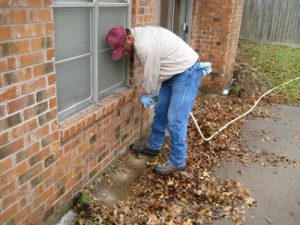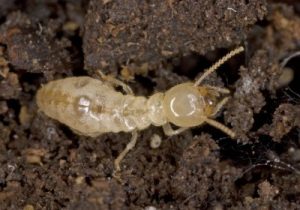
Subterranean termites are the real hidden pests for humankind. They lead veiled way of life, slowly but surely destroying our houses and wooden pieces of furniture.
In the USA, for example, there are on average from 13 to 14 subterranean termite colonies per acre, which means that a typical home may easily have three to four colonies situated under or around it.
There can be as many as 1,000,000 subterranean termites per colony; the threat of infestation becomes a very real one indeed.
Hide content
- How to Eliminate Subterranean Colony Nest Within or Outside Your House?
- What is the Best Way to Get Rid of the Termites?
- Prevention Methods
- Useful articles
- Helpful video
- Conclusion
How to Eliminate Subterranean Colony Nest Within or Outside Your House?
If you have found signs of termite presence outside or inside your house, it is worth to work out a deliberate activity plan to eliminate the nest before termites destroy your wooden furniture or entire house.
Because termites are so abundant, prevention alone may not always protect a structure from infestation.So how to treat subterranean termites? When working out a terminix subterranean termite protection plan for eliminating the colony nest within the house or yard, one should know about modern means of Subterranean termites control that have proved their effectiveness in this fight. In the particular sections below we will be speaking about what is subterranean termite treatment and which one is better to use in the different cases.
There are various types of termicide termite treatment:Termicides – very effective means of termite treatment all around the world. Because these insects get resistance towards some types of compounds, termicides are constantly improved.Liquid Termiticide Applications and Subterranean Termite Treatment Drilling – liquid termiticides are usually applied completely around and underneath a structure covering all areas where termites might gain access.
For newly built construction, this is made by treating the graded soil and basement walls before the slab is poured. So as to existing buildings, the perimeter of the foundation is trenched and drilled, then treated with termiticide.
The principal aim of such treatment is to put a chemical blanket between the termites in the soil and the structure above. In many cases, affected termites will die of dehydration.
Repellent Termiticides – are all pyrethroids (a type of chemical compound). Pyrethroids are fast acting nerve poisons that are highly toxic to termites but have low toxicity to mammals.
Repellent termicides based on pyrethroids are cheap and long lasting, but termites are able to detect these termiticide barriers in the soil and avoid lethal contact with them.
Non-Repellent Termiticides or Soil Treatment – These chemicals are not repellant and termites cannot detect them inside the ground. Therefore, the termites tunnel into the termiticide while foraging, contact the chemical, and die.
Premise contains the active ingredient imidocloprid – a unique chemical compound, that cause death to a termite with very little dose.
When a termite contacts even a very small amount of this chemical compound, it will become lethargic and forget to eat and feed on other termites in its colony.
Termidor. The active ingredient is fipronil. Fipronil can be transferred from one termite to another through contact and trophallaxis (communal feeding). It can easily kill the entire colony and it is long-lasting inside the soil.
Phantom. The active ingredient in Phantom is chlorfenapyr. The toxic metabolites of chlorfenapyr stop the insect cells from producing enough energy for living and working inside the nest. As a result, the termite soon dies.
In addition, for the treating subterranean termites you can use method which is called baiting. Termite baits consist of paper, cardboard, or other palatable food, combined with a slow-acting substance lethal to termites.
The baits are installed below ground level in the yard in cylindrical plastic stations. Termites consume the bait and share it with their mates in the nest colony, resulting in a gradual decline in termite numbers.
Another effective way to get rid of troublesome termites is termite tent fumigation. Fumigation has the advantage of being able to treat every part of the building and its structure immediately.
It is not a sort of thing you can do by yourself, only skillful experts from designated services can perform this type of treatment for subterranean termites.
The principle of fumigation is that: the entire house is covered with a huge tent and a special termicide is fumigated all around the rooms, the attic and the basement. The result – all flying termites are killed.
Recommendation: before the specialists perform the tent fumigation, remove all food and drinks from the house. Take your family and pets to the safe place.
Warning! Even post tenting and fumigation, a problem may flare up once more with termites; unfortunately, this procedure does not rid your home off termite eggs.Now, when you have an idea about different ways of how to get rid of subterranean termites, let’s discuss the most effective ones.What is the Best Way to Get Rid of the Termites?
Attention: Prevention is the best way to control termites. Be certain to deny them access to water sources, subterranean termites need this the most.
How to kill subterranean termites, destroy the whole colony at once? To eliminate a whole colony of termites at once is a very complex issue and how regrettably it may sound, it is most likely impossible.
Different termicides (repellent and liquid) have an effect on different stages of termites, for example, if you choose tent fumigation, the chemical will eliminate only the flying mature species, but their eggs and the queen will remain safely under the ground surface.
If you face the problem of termites’ colony attack on your house or yard, you better to combine two or three methods of warfighting:
- Combine Tent Fumigation and Subterranean Termite Treatment Drilling with liquid termicides. Fumigation will help you to get rid of flying termites that tend to form a new colony inside your house. The liquid termicide for drilling will slowly but surely kill worker caste of termites that will lead to the death of the queen.
- Combine Soil Treatment with Baits. Soil Treatment with non-repellent termicides will scare the termites away from your house, as well as baits will slowly decrease the population of pests near and under your house.
Advice: to choose the best treatment for subterranean termites for your individual case, do not rely upon do-it-yourself methods. Contact the specialist in your region and get the professional consultation on the spot. The specialist will advise you the best option and will help you to choose and combine different methods of termite elimination.So, as you can see killing subterranean termites by yourself may be difficult activity.Here you can learn more information about effective treatment method called tenting (fumigation): dangers for termites, preparing for fumigation and cleaning after, how long does this procedure last?
Prevention Methods
It is necessary to speak about prevention methods as it always easier to prevent than to deal with the serious consequences of infestation.
There are several preventive measures that will help you not to earn serious problems:
- Avoid moisture accumulation near the foundation. Moisture and damp are the main termites’ “friends”. These insects need water to maintain their colony safe and sound. Divert water away with properly functioning downspouts, gutters and splash blocks.
- Reduce humidity in crawl spaces with proper ventilation. When constructing the house, make sure that the basement has a sound vent system to get in and out a portion of fresh air. If there are some bushes or plants near vent ports that prevent proper vent circulation inside the basement, remove these plants.
- Remove piles of trash and dead trees stumps from the area – such objects can attract termites.
- Avoid direct wood-to-ground contact when building porches or decks.
- Siding, brick veneer or foam insulation should not extend below soil grade.
Learn more about subterranean termites: signs of their activity; DIY methods of treatment. Eastern subterranean termites and their tunnels and tubes with photo.Useful articles
If you interested in more information of termites we recommend you to read the following articles:
- All types of termites. Are they harmful to humans? Can they bite you? And what is the difference between drywood and subterranean ones?
- What does swarmers of different species look like: drywood, subterranean, formosan?
- Signs of infestation outside and in the house: in walls or furniture.
- What does termite holes look like? What is droppings and is it toxic to humans? Do termites make noises?
- Posible termite damage, how does it look like? Examples of damage in walls and wood floors.
- All about flying termites: how do they look like, swarming season and what to do if there are swarmers in your house?
- How do they do nests and mounds? How to find it in your garden or inside the house?
- Termite life cycle – from egg to larvae. And social hierarchy: workers, soldiers, queen.
Helpful video
This video will show you how to do your own subterranean termite trenching treatment around your house:
Conclusion
The best option is to prevent the appearance of termites in your house, though they are not always possible to detect before it became a real problem.
Nowadays there are many accessible and safe methods to destroy termites’ colony. But only a specialist from a termite control service will help you to choose the best option to get rid of the pests inside your house for a long-time.







